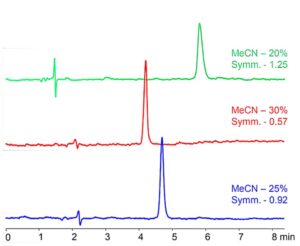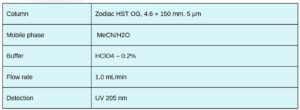
Description
This HPLC method utilizes the Zodiac HST OG column (4.6 × 150 mm, 5 μm) for the retention and analysis of polar or moderately polar analytes under acidic conditions.
The graph shows how increasing the MeCN content in the MP changes the symmetry of the Meldonium peaks. We normally would not expect changes in the (nonpolar) organic modifier’s concentration to have any effect on polarcompounds, but here we see how hydrophobic interactions play a small role in the retention of polar molecules.
Hence it also tells us that Modifying the buffer concentration is not the only way to significantly modify the retention times of your analytes. Adjusting the organic component of your mobile phase, in this case Acetonitrile (ACN or MeCN) can also have significanteffects on the retention times.
The mobile phase is a binary mixture of acetonitrile (MeCN) and water, buffered with 0.2% perchloric acid (HClO₄), providing a low-pH environment that enhances peak shape for basic and ionizable compounds. The flow rate is maintained at 1.0 mL/min, and detection is performed using UV at 205 nm, which is ideal for compounds with strong absorbance in the low UV range. This method is suitable for a variety of small molecules including amines, acids, or zwitterions, especially where hydrogen-bonding and ion-exchange interactions influence retention.
Condition

Column Name : Zodiac HST OG
Compound Name : Meldonium
Get Your Quote or Call: 040-29881474
We focus on supporting laboratory workflows & optimizing lab-wide operations
